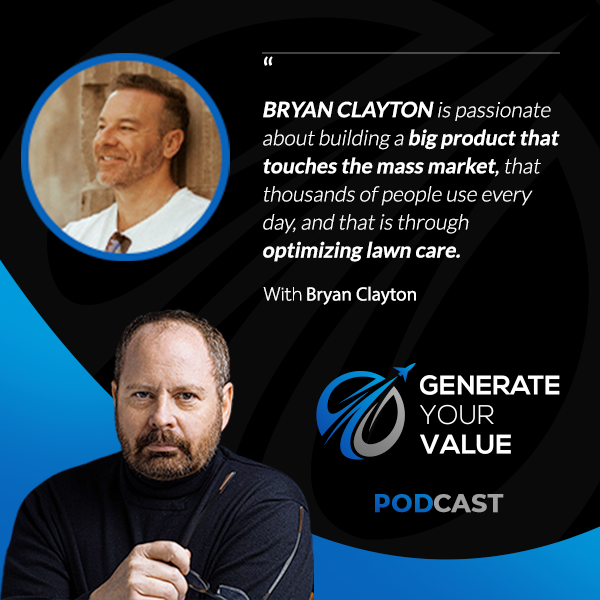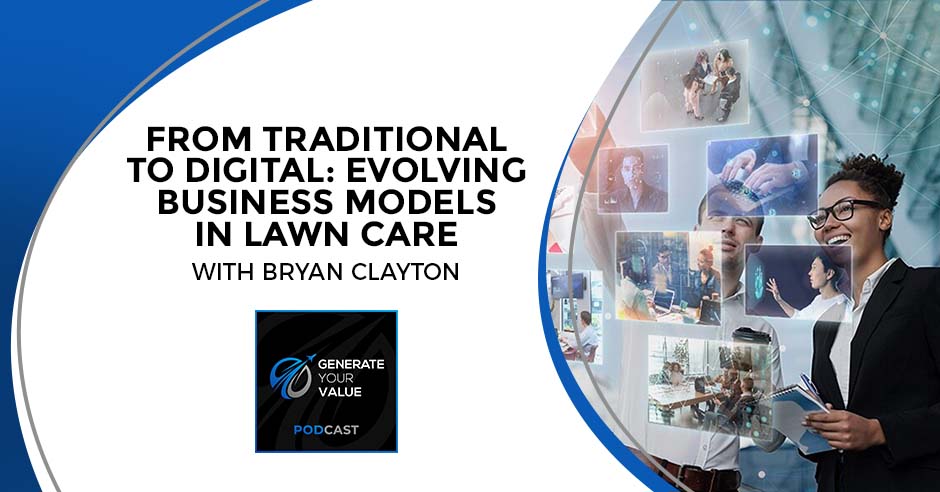In an ever-evolving landscape, industries are witnessing a transformative shift as businesses adapt and embrace changing models to stay competitive and relevant. Bryan Clayton is all too familiar with this. Within the lawn care industry, Bryan has given birth to two businesses: Peachtree Inc., considered one of Tennessee’s landscaping giants, and GreenPal, an innovative online marketplace dubbed the “Uber for lawn care” by Entrepreneur magazine. In this episode, he shares how he navigated through the pivots of running a landscaping business and moving towards a more digital approach to delivering lawn care services. From changing business models to finding labor to prospecting, Bryan takes us on his journey of finding groundbreaking ways to optimize how the industry continues to help the masses every day. Join in on this conversation and be inspired to transform and serve more.
—
Listen to the episode here
From Traditional To Digital: Evolving Business Models In Lawn Care With Bryan Clayton
I can’t thank you enough for taking that valuable resource in your life called time, that finite resource, to spend it with us. In this episode, I’m bringing you a great guest. His name is Bryan Clayton. Typically, he comes from Nashville but he’s sitting in Rio de Janeiro, of all places. Coincidence, I was watching a show from Brazil. From that standpoint, we’ve got some synchronicity going on through the universe.
As we typically do, here is Bryan’s bio and then I’ll start peppering him with questions so you get to know him a little bit better as a human being. Bryan Clayton isn’t just another CEO. He is a visionary, groundkeeper, and breaker. Those are the types of people we like to bring in. As the mastermind behind GreenPal, an innovative online marketplace dubbed Uber for lawn care by Entrepreneur Magazine. He’s revolutionizing the way homeowners connect with local lawn care professionals.
Boasting over 200,000 active users, GreenPal pulses thousands of transactions daily, a testament to Bryan’s knack for understanding market needs. Here’s the twist. GreenPal isn’t Bryan’s first rodeo. Before this digital marvel, he birthed Peachtree Incorporated, transforming it into one of Tennessee’s landscaping giants. Under his leadership, it soared to an oppressive $10 million in annual revenue, ultimately catching the eye of Luca Holdings, which acquired it in 2013. Bryan, welcome to the show. I can’t thank you enough for coming in to share your story with the audience.
Thanks for having me on, Andy. It’s great to be here.
We usually like to start by giving you the opportunity in the first 5 or 10 minutes. We learned a little bit about the life story so fill in the breaks between the lines of your story from wherever you want to start, whether it’s your childhood at two years old, college, or wherever it is. Pick a point in your timeline and give our audience an idea of what you’ve done to date so they might have that opportunity to connect with you.
I’m the CEO and Co-founder of GreenPal, which is an app that works like Instacart, DoorDash, or Uber but for gardening services. If you have a home or you rent a home, you need to get somebody to mow the yard. Rather than calling around on Facebook, Angie’s List, or Google, you download GreenPal. You pop your address in and get 5 quotes back in 60 seconds.
You can hire the lawnmowing service that you want to work with right through that. You find them, get quotes, schedule them, and pay them right through the app. If everything goes well, you push a button and it happens every week or every two weeks throughout the whole lawn mowing season. You set it and forget it. GreenPal is a multi-year overnight success.

My two cofounders and I have been at this for over a decade, building the marketplace. Now, it’s nationwide in the United States. Anywhere in the United States that has a city that’s over 15,000 people, you can use GreenPal to order a lawn mowing service. Around 300,000 people are using the app every week. Before GreenPal, I had a lawn mowing business.
I started mowing grass in high school as a way to make extra money. My dad got tired of watching me play Nintendo all day. He said, “Get off your ass. I got a gig for you. You’re going to go mow the neighbor’s yard.” He made me go cut the neighbor’s grass. I got paid $20 for that. I have been hooked on owning my own business ever since. I’ve never had a job or worked for anybody. I’ve always had my own little small business.
I stuck with that lawnmowing business all through high school and college. I built it into one of the larger landscaping businesses in the Southeast. Eventually, it was acquired by a national company. After that, I took some time off and thought, “I want to do a tech startup. Why can’t I do that?” Naivete as an asset. I didn’t realize how challenging it was going to be but I had an idea that GreenPal should exist. Somebody was going to build it. Why couldn’t it be me? I recruited two cofounders and we started working on it. That’s 23 years in 1 industry from every angle you could see it from.
You and I have that in common. I did the lawn-cutting business, too. I had a father kicked me in the rear end and said, “You need something to fill up your time besides skateboarding and doing all this other stuff. You need to start learning how to make ends meet for yourself. I’ll buy the lawnmower but it’s going to be your blood, sweat, and tears. You got to do the pushing.” It’s going to be out there pushing it and so forth. That was my first start in making a buck. I have 5 and 6 neighbors’ businesses. The hardest part was getting the phone call going, “I got a party tomorrow. Can you come over and cut the lawn now?”
The cool thing about a lawn mowing business or any service business like that is you can learn 80% or 90% of what goes into running a business from running a basic lawn mowing business. You learn things like marketing, operations, accounting, bookkeeping, and customer service. You learn how to do things like calculate if you’re making a profit or not. It took me an hour to service this customer. “I charged them X, Y, and Z. By the time I paid fuel, insurance, and equipment, did I make any money or not?”

You don’t learn that unless you’re in business. Something like a lawn mowing business is a great way for anybody to cut their teeth on what it means to run a business. You don’t have to stay in it for 15 or 20 years like I did. You can apply that to another business but what a great way to learn the 80/20 on what it means to run your business.
It is on the same scale as a side gig. You work in a corporate job and have a favorite hobby that you’re passionate about. You’re good enough to build a product or service that people are willing to spend money on. You can keep it small. You can learn about what it takes to run a business and all the mechanics. Keep it at a comfortable size but you learn a ton out of it. Should you decide to jump ship from the corporate world and make it a full-time business, you’re about 80% to 90% on the way.
You didn’t feel like you needed to go to college. Was it the cutting of the lawn that you were passionate about or counting the almighty $20s and making money that was the draw for you? You could take or leave cutting lawns but it was the fact that you were making money and somehow providing for yourself. What was the draw to say, “College is not for me. I’m going to keep going here?”
All of the above. A couple of things. No, I did not want to go to college. I thought it was a waste of time. As it turns out, it was. I did go to business school but I went at night so it took me seven years. I went from 6:00 to 10:00 every night for seven years and got a Business degree. At the time, I was running a small business during the day, mowing yards. I would show up to night school with grass all over me, smelling like gasoline. My classmates hated me.
I would be in a marketing class or a business operations class. I would be like, “This is not how small business works.” It was this weird thing because I was running a decent-sized business at the time. I had 2 or 3 employees, $200,000 or $300,000 a year in revenue. I was thinking, “There’s a disconnect here between what I’m learning in business school and what goes into running a small business.” It was pretty much a waste of time and money but I got it done.
What little I learned from business school, I wrote a business plan when I graduated college. I didn’t want to be a lawn guy my whole life. To your point, I was not passionate about the lawn mowing business, and I still am not. I hate the smell of fresh-cut grass. I pray to God that I never have to mow another yard again in my whole life. I hated it but I was passionate about building something bigger than myself and had a great reputation in the little marketplace that I was in, which was prospering, thriving, and growing.
I was passionate about winning. Owning a lawn mowing business gave me access to that. I could say, “I started with me and a push mower, and now we’ve got 80 trucks going out of this big building every day. All of that started from that.” I didn’t do it all myself. I had a great team around me. It was fun to be a part of building something and putting it into the world. The grass was the vehicle for that.
Following your passion is bad advice because it’s rare that you can make a living and make any profit off something you’re super passionate about. Some people can but it’s very rare. If you can get passionate about the process, results, and journey, you don’t have to be passionate about the thing. That’s how it was for me then and now.

I still don’t like lawn mowing but we have the world’s largest network of lawn care services you can hire from a smartphone with GreenPal. Am I passionate about lawn mowing? No. However, I am passionate about building a big product that touches the mass market, building something that thousands of people use every day. That’s a lot of fun. It’s important to remind yourself of that.
I still think it’s important to find the passion but to your point, it’s something you’re passionate about in the business. It doesn’t necessarily have to be the product or service that you’re offering. It could be you’re passionate about customer service. You’re an extrovert. You love people, the process of selling, and helping people out. That’s what you’re passionate about.
You don’t have to do what you love but you have to find the love in what you’re doing. For me, a lot of that came from the employees who worked for the business. That was a lot of fun. I had 150 people who depended on the business at any given time. I watched them come to work for me as an entry-level laborer and grow in the business into a manager.
You don't have to do what you love but you have to find the love in what you're doing. Share on XI see that they’re driving a better car than they were when they started working for me. They put a down payment on their house. Their kids go to good schools. They’re getting access to the American dream as part of this thing that I’m a part of. That was a lot of fun. I loved that. I hated mowing yards. It’s important to find love in what you’re doing.
Did you get beyond mowing yards? Did you get into landscape design or planting of plants and that kind of thing?
All of that. As time goes on and you’re in that particular industry, it’s impossible to scale it on the weekly $35 lawn mowing. You have to get into bigger contracts and installation services like trees, shrubs, and irrigation systems. We did snow plowing. As time went on, we grew the business to be solely a commercial business. We would only do office parks, apartments, HOAs, and things like that. That was the inspiration for building GreenPal.
I grew that business from a residential business to a commercial one. We would still get phone calls every single day, people begging us to come mow their yard. They would call ten different lawn care services and nobody would ever call them back. We would keep a list of names and phone numbers by the phone. We had a value in running that business to always try to be helpful no matter what.
We would refer out 5 or 10 different service providers. In effect, we were like this little connector service. When that business got acquired, when I sold it, I thought I was an Uber for lawn mowing service on a very small scale in Nashville, Tennessee. Somebody’s going to build an app that does all that stuff we were doing manually. Why can’t that be me? That was the idea for building GreenPal. It was the hand cranking that we were doing in the first business.
In my corporate career, I worked for Boeing on the services side. Everything was project-based. It was all labor. Our strategic advantage was the intelligence inside my team’s heads. The one thing I had to pay attention to was the number of projects coming down the pike and what my staffing level was. That was where my boss and I had the most conversations. When was it appropriate to hire that next person? Did we have enough business in the pipeline to justify hiring another person? That’s what I paid attention to the most on my dashboard, if you will. What would you say in your landscaping business? If you had a dashboard on your business, what was the number one thing you always keep your eye on?
It’s so funny how it’s very similar to what you described because in that business, running a landscaping business and in the business that we’re in, we’re in the business of selling man hours or labor hours. The unit that’s flowing through the business is a labor hour. We have to be cognizant of, “What does it cost to deliver that hour of labor? Is that mapping to what we’re billing the customer?” I made a huge mistake in the early days of running my first business. I was throwing bodies at a problem. We can’t hit a deadline. We aren’t getting all the work done. It’s not to a certain quality level. Whatever it is, let’s throw more people at it.
I imagine that’s similar to what you’re describing and that tension of no, you can’t throw more people at it. You have to look for where the waste is. Where is the process inefficient? For us, a lot of times, it was routed through town, avoiding traffic, and going from stop to stop as quickly as possible. We were coming up with a standard operating procedure of first getting the lawnmower off the truck, then mowing, trimming, and blowing off the grass clippings. You walk around one time that way you make sure you don’t have to go back. It’s that standardized process. Finding and driving operational efficiency in the business is what capitalism is all about.
That standardized process and finding and driving the operational efficiency in the business is really what capitalism is all about. Share on XGovernments and big bureaucracies don’t do that. They don’t have the evolutionary pressure to do that. Even as something as lawn mowing, we would look for what is the most efficient way to do these twenty stops in a day and not have to go back, fix them, and make sure the customer’s happy. That was the main thing that we were always optimizing. It never ended. With GreenPal, that’s what our software helps lawn care services do.
Let’s say you’re a one-man band. You want to do 20 or 30 customers a week. You don’t know the first thing about operational efficiency and all of these things that go into running an efficient business. It’s our platform’s job to help you through that. It’s like, “Here’s your twenty customers. Here’s the fastest route to go but from stop to stop. Here’s what they expect. Here’s all the details that they want so you don’t have to go back and fix something because you forgot.” We’re giving them a business in a box so to speak.
Project management in a box.
All we do is focus on that. It’s hard to be good at anything unless you focus on one use case. We’ve spent ten years focusing on this one use case of grass is this tall. I need somebody to make it short, nice, and neat. We don’t do anything else.
It's really hard to be good at anything unless you just focus on one use case. Share on XBack in that day, how difficult was it for you to find labor and resources? Are you glad that you did that pre-pandemic?
It was hard then and it’s hard now. I don’t know if it was harder then or if it’s harder now. Sometimes, I wonder. For us, that was one of the biggest choke points. It was finding good laborers, bringing them in, training them, and keeping them for longer than six weeks. That was one of the hardest parts of the business. For five years, I would beat my head against the wall and be pissed off at the world like, “Nobody wants to work. Nobody takes pride in their work anymore. It’s their fault.” When you’re in business, everything is your fault.
I had to look in the mirror and say, “You dummy, you built this. You need to work on the business and quit working in the business.” I spent a year building what I called Lawn Care University. We would hire somebody. Rather than it taking 3 months to train them on everything that it means to be a good gardener, we compressed that down into 2 weeks. It was on the job and a training system that was module-based. This was many years ago. It was multimedia. It had little tests and stuff.
You can get this stuff out of the box. There are platforms that help you do this. A lot of small business owners still don’t do it but it’s a lot easier now than it was then. That helps solve that problem where it’s like, “Turnover still sucks but at least we can train somebody in 2 weeks rather than 3 months.” We could at least not have to bleed so badly on that side of the problem.
If you can look at some of these big challenges your business faces by thinking, “What is the system that I can build to help me solve this problem rather than beating my head against the wall, facing it ten times a day,” it’s harder to do that. In business, you’ve got to work hard but you’re also going to have to do the difficult work. It’s important to make time for the difficult work and know the difference between hard work and difficult work. Building Lawn Care University was a difficult work.
Hard work is going through the frustrating experience of hiring somebody, losing them in a month, and retraining somebody else manually. Difficult work is building the system that solves it. We still do it with GreenPal. At least, we’re a systems-based business where it’s all technology-based but it’s very much the same problems. As a business owner or founder, you have to become a never-ending problem-solving machine. Just because you solve one problem doesn’t mean you’re done. It means you get to solve five more.

It’s a life of continuous improvement.
That’s what makes it fun.
I have a good friend in the handyman business. He’s taking the same route as you did in building, as you called it, a university where he trains the staff in customer service and the best way to execute the job and so on. Since he’s also got labor issues and needs some skilled labor, he can get them up and run a lot faster like you did.
It’s hard for him to build that system. All of his competitors are probably complaining about doing the work themselves and repeating the same ten problems every day. He’s smart enough to know, “I’m going to build a process or a system that my competitors don’t have.” That’s how you build defensibility between you and ten other companies that are doing the same thing you’re doing. It’s not fun. There’s no roadmap for this stuff. You’ve got to make it up as you go.
He only services the Atlanta area but he’s outsourced that university to other people in the business. He does a bang-up job with it. Your staff is all over the city. You’re having to remote lead or remote manage folks that are spread during working hours all across Nashville at the time. What was your command and control like? Did you have site leaders or team leaders who were responsible for making sure the work got done? How did you go about dealing with that aspect of your business?
It was something that I did wrong for a long time. Ultimately, the business grew to around 150 people and there would be 90 crews going out every day. Usually, a crew could be 1 guy, 2 guys, or 3 guys depending on the size of the job. It was very much modeled in duplication in the sense that I started with just me and then I got me and a helper. I got me and another helper. I want to replicate that with another crew. It’s going to be me running one crew and then one of my helpers can go work by himself for a while. Let’s get him another guy. It’s slowly building it out. That was a good solid foundation.
Where that gets tricky and where the wheels fall off of that is you throw bodies at problems. The next thing is that your payroll is $10,000, $15,000, $20,000, $50,000, and $100,000 a week. You don’t have enough money in the bank to make payroll. That happened to me several times throughout the fifteen years of running that business. If you’re not careful in terms of mapping what these individual crews are doing in the field and what you’re billing them out for, it was a very much manual process in those days. Now, there are systems and platforms you can buy off the shelf that help you with this. It was very much pen and pad and spreadsheets and bean counting.
It was the difference between staying in business and making a profit versus going out of business. A lot of service-based businesses like that go out of business because they don’t do the difficult work of constantly reconciling, “These crews that I’m sending out, are they unit economic sound? Are they contributing margin to the business or am I losing money on jobs?” Most small business owners in this industry don’t know either way. The only metric they look at is their money in the bank. That’s not a way to run a small or big business. That’s how we built it.
The operating core was there would be a crew foreman. He was responsible for all of the clients. He could be by himself or have a helper. He could have as many as 4 or 5 people, depending on the size of projects we would give him. There would be an operations manager who would manage 4 or 5 of those guys. There was a GM that managed all of them. That was the operating core. On top of that, we had a sales engine at the core of the business where we would go out, prospect, and outsell our competitors on these types of contracts. I did that myself for a very long time. I had a sales manager. At the end of the business, we had 3 or 4 salespeople. All they were doing was selling business.
Mapping that to what the operating core was doing and making sure that they were in sync and jiving was always a challenge. It was a tough business to run. It was very hands-on. I used to joke that if I went away for longer than 2 or 3 days, I would come back and there would be a smoldering crater where the business was because it was always very much like you had to have your hands on it.
That’s why when I started GreenPal, I wanted to start a business that I could run from anywhere in the world. I wanted to run a systems-based business, a technology business. It took a while to get it going but I travel 10 or 11 months out of the year and this business is growing. Our team is 47 people. I can run GreenPal from anywhere. That’s a lot of fun. That is baked in fifteen years of being chained to my office and desk running that first company.
I know all about that. With Boeing, 50% of the year, I was somewhere else in the world, being on-site with clients and working on projects. Let’s stay on that sales track. With a landscaping business, you had a team of people that was out there getting business and prospecting. How is it that they would generate leads and find the business? How did that translate over to GreenPal? Was there anything about the prospecting or sales process you had in landscaping that was translatable into the platform that you built with GreenPal?
It’s funny how different the two journeys are. The first landscaping business was about 5 or 6 years in. I realized I wasn’t in the landscaping business at all. I wasn’t in the lawn maintenance business or the business of planting trees. I was in the sales business. I had to figure out a way to connect what it was we did with the potential clientele that appreciated what we did. That took a while to figure out. The second business, GreenPal, is different. It’s all inbound. We don’t have salespeople who call people up, “Can we come cut your grass?” We are where you are searching when you need a lawn mowing business. It’s very much inbound.
“I need a lawn mowing service, lawn care near me,” GreenPal pops up. The two are very different in terms of how we marketed the first company and how we marketed GreenPal. There is one thing that’s the same. It’s use cases, not personas. A lot of times, when people are talking about marketing, they’re talking about, “You need to have this persona of who your customer is, what they look like, and who they are, what their demographic is, and all of this stuff.” Maybe that’s important but what I have found is more important is use cases. What is the use case of the product and service that you are delivering? How does that map to what people are looking for and needing?
With GreenPal, the use case is it’s the easiest way to get a lawn mowing service to mow your yard, even if your grass is 4 feet tall. It is not a private gardener or landscape design service. I don’t care if you live in a $1 million home or a $100,000 home. That is what it does. That is the use case. Peachtree, my landscaping company, was very similar. If you’re managing 30 or 40 locations over a geographical area and you don’t want to deal with 40 different vendors, you want to deal with 1, I have a product for you. That’s all we focused on and attacked. We didn’t worry about anything else.
We went after the facilities managers who were looking for a partner to manage a big portfolio of locations. We sold into that. We didn’t try to compete anywhere else. That’s how we built a $10 million business, which is focusing on one use case, being the best in the market at that, and connecting what we did with what they needed. You could say, “We’ll mow the lawn at McDonald’s for $50.” There are 1,000 different people they can call to do that. What we would do is say, “Facility services manager for McDonald’s, we noticed at your location and outside of Nashville some pictures of the drive through and it’s full of cigarette butts.”
“I know that you probably have people that handle that and you have systems that make sure there aren’t supposed to be cigarette butts there but you can see, there’s more cigarette butts than mulch. Here are some before and after pictures. We went ahead and cleaned all those up because we believe that if there are no cigarette butts in the drive-through, you’ll be able to boost sales on extra value meals.” We would tie what we did to what their objectives were.
We would do the same thing with apartment complexes. We would say, “Apartment complex in Brentwood, Tennessee, what is your occupancy rate?” “Eighty-nine percent.” “We hear that the average is 95% and we believe we can get you to 95% with these five landscaping enhancements. Here’s how we’re going to roll them out.” We’re no longer talking about the cheapest grass-cutting service. We’re talking about how we get you where you’re trying to go. That’s how we grew that business to eight figures. We never would’ve been able to do it if we’d been doing what everybody else was doing.
It was more about being a strategic partner to say, “We want to have skin in the game in your success. We can offer a team of people to come to your facility at a given time. If we’re only looking at the outside part of your facility, here’s the list of a myriad of things that we can do to get you to have that picture of what you want the product to look like.” Some of them involve grass and some of it doesn’t. It’s about the aesthetics of the place.
It’s not that competing on price wasn’t a good strategy. Competing on price was impossible because a little dirty secret in that business and maybe even others was that buyers of these services would hire a company knowing they would lose money on the contract. They were the cheapest and did not care if they would go out of business in a year. They would rinse and repeat every year or 2 or 3.
They don’t care if they’re destroying your business by signing you up for a contract that you’re going to lose money on. That would happen all day long all over the place, where new entrants into the market, not knowing what they were doing, would compete on price, sign up for a contract, and go out of business 1 year or 2 later. There would be a new batch of them every couple of years. It’s not like competing on price was a bad strategy. It was impossible. You’d go out of business.
It’s also shortsighted. One of the things I talk to my business owner about in terms of my clients is your lifelong relationship with a client. When you’re looking at sales, marketing dollars, and those types of things, are you only doing the analysis over the next 3 months or 12 months of your business in terms of your capture cost for a client or are you looking at a long-term like, “I hope to have this customer for 10, 15 years, or 20 years,” whatever your goals are for your business. I’m looking at the lifetime revenue for the customer. I’m willing to spend a little bit more sales and marketing dollars on that customer to capture it because I’m looking at the big picture as opposed to my sales and marketing budget for the year.
It’s hard to build a small, medium, or big size business on unhappy customers and customers who don’t stay with you for a long time. The first step is fixing the leaky bucket and figuring out why customers don’t stay with me longer than 1 year or 2 or 3. There really should be no reason. They don’t want to go out and shop, unless they are looking for the cheapest price every year. You can’t break them of that mentality. Most of the time, they’re not. That’s the first thing, fixing that. Knowing what the lifetime value of the customer is is difficult work.

That’s studying past data that’s looking, “Look at my last 100 customers. How long did they stick it out with me? How much do they spend? What are they worth to me as a business owner?” That informs how much I can spend to acquire more of them. Once you figure that out, you’ve got pretty close to a money printing machine where you know, “Customers are worth $10,000 to me. I can spend up to $10,000 to get them. I can build out a sales team to do that or do inbound marketing like we do with GreenPal to acquire more of them.” That’s how you grow a business from $1 million, $3 million, $5 million, $10 million, and beyond.
What are you doing to analyze your best customers? If you have 100 customers and say, “These ten, for whatever reason, are my best customers,” what makes them your best customer? Can you find more of those? Focus on those sets of customers as opposed to saying anybody with a wallet and some cash in their wallet is a customer. Going after the almighty dollar at whatever cost, all it does is create a big anchor for you and sink you.
In the early days, when you’re trying to cobble together your first $100,000 or $250,000 of revenue, you have to do anything you get your hands on. As time goes on, you need to niche down and figure out who the ideal customer is for you. One thing we found when running my landscaping business was that we had the 80/20 rule, where 80% of the profit came from 20% of the customers. On the flip side, 80% of the customer service, problems, and headaches would come from 20% of the customers. It was the inverse of the unprofitable customers.
We had to make the hard decision of, “We have to get shed of the bottom 10% of customers every year and go after the ones that we’re a better fit for.” When you’re running a business like that, you have to do that difficult work. Otherwise, you’ll have this business where you’re trying to be all things to all people and end up hating it because you’re not good at any one thing. It’s like organized chaos. It’s hard to fire a customer but sometimes you have to.
The hardest part is recognizing the fact that your customer is not a commodity. Not every customer is Joe Smith that’s the same. You’re not rubber-stamping every single customer. Every customer is unique and different and brings a different value to your business. It’s a lot of work but you have to figure out which ones are the better ones. How can you track that set and get rid of ones that are not bringing much to the table for you?
When you get rid of them, try to hand them off to somebody who wants them. If we would deal with this with my first business, we would try to put them in a place where it’s like, “Here are 2 or 3 colleagues that we know that do this type of work.” They’re grateful to get it. They don’t feel bad. Maybe they come back or give you a good recommendation. We do this with GreenPal.
We’re not a landscape design service, a private gardening service, or a lot of things. We are the easiest way to make tall grass short at the touch of a button. When we have somebody that comes through our customer support chat and we identify that we’re not a good fit for them, we give them 3 or 4 other websites they can go to that specialize in that thing. They’re happy. They don’t barbecue us on Trustpilot, Google reviews, or Yelp. That’s a better way to run a business.
Going back to the name of my business, Generate Your Value, how are you going to generate value for every person that comes to your doorstep? Whether they end up being a paying customer or not, how is it that I can add value to this person’s day? It’s value in what’s called goodwill. They’re going to remember that. Maybe it comes back to you in some other fashion.
It’s hard to measure but a lot of things in life, whether it’s dieting, relationships, or building a business, you make these invisible deposits every single day. You can’t measure any of them. Over the long haul, it always pays off.
Educate the customer. Customers are not stagnant. Their needs may change. Down the road, you would be a good fit for them if you educate them on that. They know, “I’m going to go see Bryan because my needs have changed and I’m a good fit for him.”
Also, recommend you. You’re making deposits into that goodwill and that also is your brand. You’re making deposits into the equity of what the brand of the business is. The thing is it doesn’t cost anything to do a lot of this stuff anymore. When we were running our first business, and we would refer people to smaller service providers, it didn’t cost us any money to do that. That helped out a lot of small business owners and consumers. Maybe some of them came back to us and did some business later or not but that gave me the idea for GreenPal. As it turns out, those deposits of goodwill are the reason why we are where we are. It’s because I decided that that’s the type of business I wanted to be a part of.
It’s about a mindset and an attitude. That doesn’t cost you any money. You sold your landscaping business and that enabled you to bootstrap GreenPal. Can you talk a little bit about the pros and cons, what you like, and what you didn’t like about the bootstrapping process that enabled you to crank up GreenPal after selling the landscape business?
I sold the landscaping company, which was a great event for me. It wasn’t like I was super wealthy or anything but I didn’t have to work anymore. I could do what I wanted to do after that. I decided that from that day on, I was going to do what I wanted. I wasn’t going to work in a business I didn’t enjoy being in. That’s how I started GreenPal. It was like, “This is an interesting idea. It could touch the mass market. There could be maybe one million people using this one day. It would be fun to pour my life into this.” I’m not going to work on it if I don’t enjoy it. I’m not going to do anything I don’t enjoy doing.
The first thing is you read a lot of the tech press and books on getting a tech startup going. They tell you, “You got to go raise a bunch of money.” A lot of times, you do but that didn’t appeal to me because I sold a business. I’m having to run all over town and beg people for $20,000 checks. I didn’t want to do that. I tried it and it wasn’t fun. I thought, “I’m going to put my head down and build a product that people want to use. I don’t care how long it takes. I’m going to fund it off of its revenues.”
It wasn’t like I took all the money from the sale and plowed it in the GreenPal. I didn’t do that because I didn’t want to go backward. I hate the smell of fresh-cut grass. I never wanted to mow another yard again. I locked all that down. GreenPal had to sing for its supper and that kept us manically focused from day one on customers because we needed them to use the product so we could figure out how to make the product better. We also flat-out needed the revenue.
From our first 10 customers to our first 100, 500, and 1,000, we treated them like gold. We listened to them and solicited their feedback because we wanted to make sure we could, A) Keep them happy to keep them using the product, and B) Make the product better so the mass market eventually could adopt it. We’re many years in and still doing that, listening to thousands of people every day. How do we make ordering a lawnmower service quicker, cheaper, faster, smoother, more convenient, and more reliable?
Bootstrapping was the right course of action for us. If I had to go back in time and do it all over again, the first thing I would do is raise a bunch of money because I know all the things I need to do. Back then, I didn’t. If you had given me $5 million, I would’ve pissed it all away and probably, we wouldn’t have built a successful business. Venture capital and outside capital usually ruin more small businesses than it helps build and grow. If you’re a first-time founder, bootstrapping is usually a better bet.

As a business coach, I sit in the camp that says the number of pages in your business plan should match the amount of time that you’ve been in business. I’ve seen folks who sit down and write a business plan that’s 50 pages long to launch a business from scratch. They lose the thought or the notion that starting a business is a learning process. The biggest section in your business plan should be labeled assumptions.
“Here’s our assumptions about the business. There’s a market need out there. Pricing should be in this neighborhood. The cost structure is X.” These are all our assumptions and why we wrote the business plan the way that it is. Our number one job after launch is to validate or invalidate those assumptions. We got to change on the dime. If we invalidate an assumption and it’s something different than we thought it was, we’ve got to pivot very quickly to change the business plan so that it runs off the new assumption.
That’s exactly how I experienced it.
That’s what the bootstrapping process allowed you to do. It helped you hone in on that because you were constantly getting customer feedback. You were validating or invalidating your assumptions about the business and changing on the fly if you found that’s what was invalid.
Survival depends on it to be successful. If you don’t do that, you die quickly. Whereas if you raised $100,000, $500,000, $1 million, $2 million, or $3 million, you set off on this journey of assumptions and stay the course. The feedback loop is a lot longer in terms of whether it’s working or not. The reality is going and sitting down at somebody’s kitchen table sucks. Sitting down at a Starbucks and hearing somebody ream you out about how crappy your product is sucks. Nobody wants to do that. If you have $1 million in the bank, you don’t do that. You stay behind the laptop and keep working off your assumptions.
If you don’t have any money and you have $10,000 of overhead that month, you know you got to keep that customer so you go and talk to them. You say, “Mrs. Smith, I noticed you signed up and used our product last month and you haven’t been back. What’s going on? Can I buy you a coffee at Starbucks? I’d love to hear everything that you liked about it and what you didn’t like about it. We have this new feature. I’d like for you to test it out. I’ll give you a $100 gift card to Amazon.” Meet with your customer face to face, belly to belly. Survival depends on that if you don’t have any money. If you have a bunch of money, then you can paper over that. In a weird way, it prevents you from not being successful.
If there’s one thing the audience takes away from our conversation, I hope that’s it because that’s where most new business owners and those who are launching businesses fail. They don’t realize that their number one job is to be validators and validate things about their business model.
It comes from one place that’s the customer. As simple as this stuff sounds, it’s like dieting. We all know how to lose weight and get in shape but it sucks and nobody wants to do it. We look for every other way to do it. Building a business is no different. It’s the same thing.
Bryan, unfortunately, our time is coming to a close. I can’t thank you enough for coming and sharing your story and wisdom with the audience. We do have one last question to ask you. We ask every guest this question because we like to see what the answers are and where that thread is amongst all the answers. That question is, what do the words Generate Your Value mean to you?
I could answer that 100 different ways, but I guess here’s one way that’s top of mind. Somebody was asking me and it was a new founder that I was helping out. He said, “I’m going to this networking event. I can’t get anybody to take me seriously.” I had to tell him, “It’s not who you know. It’s what you’ve built.” In that context, don’t even worry about networking. Build some cool stuff and then people like your cool stuff.
Generate your value: it's not who you know, it's what you've built. Share on XBefore you try to network your way to success, It’s important to generate your value, put your nose down, and spend 1 year or 5 years building something cool and successful that’s thriving and helping people. Your network grows from there. I see this mistake from a lot of new founders. They think that somebody’s going to put them on. Do cool stuff and then that comes. To me, that’s top of mind for generating your value. It’s not who you know. It’s what you’ve built.
If people wanted to reach out to you about GreenPal, talk to you about your story, or network with you in some way, what’s the best way to reach Bryan Clayton?
Life’s too short to waste time mowing your yard so go to GreenPal.com. If anybody wants to hit me up, Instagram’s a good place to find me. I post a lot there at @BryanMClayton or you can find me on LinkedIn. Hit me up and I’m available on both of those.
Thank you so much for taking that valuable resource in your life called time to come spend it with us. Bryan, we call them Golden Nuggets around here. We hope you, the audience, got some golden nuggets out of our conversation that you can take and integrate into your business, life, leadership, or whatever it may be, and it delivers value to your life in some way. If you like what you read, be sure to not only subscribe to the show but also share it because of the value that the content gets created between Bryan and me in this conversation.
If it doesn’t get out to the people and they consume the content, can we truly say that the value is delivered? We can’t encourage you enough to share this episode if it brought meaning to your life so that others might be able to get something out of it as well. With that being said, we’re here every week with guests like Bryan. We’re available on all the major platforms and then on YouTube. We’re on video. We hope you’ll check out other episodes of the show. Have a great day. We’ll see you next time. Take care.
Important Links
- GreenPal
- @BryanMClayton – Instagram
- LinkedIn – Bryan Clayton
- YouTube – Generate Your Value
About Bryan Clayton
 Bryan Clayton isn’t just another CEO; he’s a visionary and a groundbreaker. As the mastermind behind GreenPal, an innovative online marketplace dubbed the “Uber for lawn care” by Entrepreneur magazine, he’s revolutionizing the way homeowners connect with local lawn care pros. Boasting over 200,000 active users, GreenPal pulses with thousands of transactions daily, a testament to Bryan’s knack for understanding market needs.
Bryan Clayton isn’t just another CEO; he’s a visionary and a groundbreaker. As the mastermind behind GreenPal, an innovative online marketplace dubbed the “Uber for lawn care” by Entrepreneur magazine, he’s revolutionizing the way homeowners connect with local lawn care pros. Boasting over 200,000 active users, GreenPal pulses with thousands of transactions daily, a testament to Bryan’s knack for understanding market needs.






